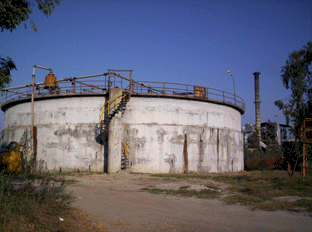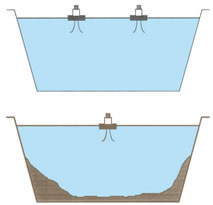

Aeration Fundamentals Primer Need to know more? Send us an email or feel free to search our online series with our give away search engine: |
The volatile solids content of the mixed liquor in an activated sludge process typically is considered to represent the mass of microorganisms that is available for waste treatment. However, not all volatile solids are active microorganisms. Inert cell matter and volatile but nonbiodegradable influent solids also contribute to the mixed liquor volatile solids. Oxygen uptake occurs when active microorganisms consume biodegradable constituents of the wastewater. Respirometer-aided methods can provide oxygen uptake measurements which can be used to estimate actual active biomass in mixed liquors. Case studies show that mixed liquor volatile solids typically range from 5 to 25% active microorganisms.
We can't go much higher in MLVSS than about 2,000 mg/L and still get good oxygen transfer in the aeration basins.
For conventional activated sludge of average rate, i.e. medium rate, it is generally recommended approximately 50 lbBOD/1,000 cu.ft. as maximum. For process stability and better assurances of performance, [fine pore/fine bubble] diffused aeration systems favor the use of low f/m and that is generally restricted to about 10-15 lbBOD/1,000 cu.ft. This significantly lower rate sizing tip takes into account process recommendations (extended aeration) as well as diffuser technology old hands recommendations.
Design of the aeration tanks is also important for optimum efficiency. Fine bubble diffusers can work at 2.5 water depth but deeper basins will give greater efficiency and superior results on capital costs. Diffusers are directly dependent on liquid depth for their aggregate efficiency. As a result, if the basin depth is doubled, it will approximayely use the same horsepower but it will take only roughly one-half the number of required diffusers, i.e. capital cost of the diffusers is about 50%. Using deeper basins, e.g. 5m, and larger volumes offer much better assurances of performance. It must be said that one of the authors once witnessed a probably still exisiting wastewater treatment plant at an edible oil plant having a detention time of ... [only] ten (10) minutes.
The following approach can be used to estimate oxygen requirements for most common industrial and municipal wastewater aeration applications:
Ro = (1 - b * Yg ) * Rs + b * d * X , mg
O2/L-hr
where:
Rs = rate of COD conversion, mg COD/L-hr (usually COD load * removal
efficiency),
Ro = rate of oxygen uptake, mg/L-hr,
X = microorganism concentration, mgVSS/L
Yg = biomass yield coefficient, mass VSS/mg COD removed (usually 0.3 kg
VSS/kg COD removed)
b = 1.42
d = endogenous decay rate (usually 0.1/day)
So for 42 mg COD/L-hr maximum COD loading
rate ( = 1 g COD/L-d) and an assumed 2,000 mg/L VSS in the mixed liquor
and an endogenous decay rate of 0.00417/hr (= 0.1/day), the oxygen uptake
rate would be:
Ro = (1 - 1.42*0.3) * (42 * 90%) + 1.42 * 0.00417 * 2000 mg/L = 34 mg
O2/L/hr
The aeration equipment would have to equal or
exceed this rate to insure positive DO in the aeration basin. Of course,
you will need to make sure you calculate the loading rates correctly in
the zone of interest. For example, for plug flow type processes, the COD
loading rate would be that in the first section of the basin.
Most manufacturers and equipment vendors have
readily available software for preliminary designs and will generally
assist you with proper equipment/unit selection including
recommended/minimum/maximum depth, oxygen dispersion diameter, complete
mix diameter and so on.
Rightly or wrongly, AOR/SOR ratios of about 0.7 are frequently used for quoting or budgeting direct-drive, surface mechanical aerators. However, until alpha, beta, theta, elevation and required residual D.O. are known the 0.7 factor is nothing but a glorified guess. It should be obvious you don't want this type of guessing especially in the light of present day availability of highly qualified treatability assessments.
It's illustrative to see how each aerator manufacturer decides to
showcase their units. The following argumentation was proffered by a
manufacturer of both surface aerators and submersible
aerator blower combinations:
"Based on a flow rate of 1200 m3/day and a BOD of 1043 mg/l and
TKN of 11 mg/l we calculate that the AOR will be 4385 lbO2/day. Using a
correction factor to SOR = 8570 lbO2/day = 357 lbO2/hour.
With our surface floating mechanical aerators at a transfer efficiency of
2.5 lb/Hp/hour you will need 142.8 BHp. Due to the shallow basin [swd=3.5m]
we recommend three (3) 50 Hp (37.3 kW) aerators of stainless steel float
design.
If you can change your basin size to 16.5m square by 6.1m liquid depth
then we would recommend one (1) 30 Hp submersible aerator mixer supplied
air from one (1) 75 Hp blower with accessories. Total energy draw will be
30HP for the submersible aerator mixer and 64HP for the blower for a total
of about 94 Hp (70 kW).
The submersible aerator mixer can either be hydraulic driven or electric
driven at the same cost. The submersible aerator mixer and blower
combination should save over 40 Kw of energy costs and this should more
than pay for the capital cost difference in less than two years."
Adequate contact must be provided between organic wastewater constituents and the
microorganisms. Mechanical aerator manufacturers often provide
sizing charts or layout guidelines including recommended water depth, oxygen dispersion diameter and complete mix diameter estimates, the following being sample formulas for low-speed, floating
surface mechanical aerators:
Mixing diameter (feet)
= 2 x (( 646 x H.P.)/DEPTH)^0.5
Oxygen dispersion diameter (feet) = 2 x ((6490 x H.P.)/DEPTH)^0.5
One surface aerator manufacturer's rule of thumb suggests that the HP/mg power density required for mixing with up-draft, direct-drive aerators is up to 1 HP/1,000 ft3 or about 133 HP/mg.
A common rule of thumb indicates the air volume required to mix a tank is 0.12 cfm of air per sq.ft. of flat floor area in the tank This is a way of showing or representing the actual energy requirements per square foot of tank floor. The reason the 0.12 cfm per square foot of tank is used is to eliminate the variable of depth from the calculation. Regardless of the depth of the tank one ends up with a proportional energy per unit volume. Using a value of 20-30 cfm of air per 1,000 cu.ft. as some engineers do, may be a disproportionate amount of energy requirement for deep tanks which may not be realistic. One must understand the 0.12 value as pertaining to biological solids only. If it were a tannery wastewater with a lot of heavy material or difficult solids, one could suggest the energy level for mixing be increased to 0.15 or possibly even approach 0.2 cfm per floor square foot. This is a determination based on the characteristics of the solids to be handled. For instance, for aerobic digesters one could/would specify 0.2 to 0.3 cfm per square foot because of the high concentration of solids and more difficult mixing conditions.
 There is a MAJOR difference between a lagoon aerator and an activated sludge aerator. Lagoon aerators are designed to keep the upper aquatic zone aerobic but not necessarily mix the bottom solids. Activated sludge aerators are designed to mix all suspended solids for maximum contact with biomass and oxygen, and keep the bottom of the basin clean -- that is no sludge deposits. Thus, some lagoon type aerators would not work well for activated sludge type applications such as some BNR systems.
There is a MAJOR difference between a lagoon aerator and an activated sludge aerator. Lagoon aerators are designed to keep the upper aquatic zone aerobic but not necessarily mix the bottom solids. Activated sludge aerators are designed to mix all suspended solids for maximum contact with biomass and oxygen, and keep the bottom of the basin clean -- that is no sludge deposits. Thus, some lagoon type aerators would not work well for activated sludge type applications such as some BNR systems.
Some floating aerators are OK for facultative lagoons but do NOT provide the deep mixing needed for aerobic basins in activated sludge processes.
Fine bubble aeration is acceptable from an AS process point of view but is best suited for rectangular tanks and requires a separate blower building and controls. Fine bubble systems are not good for earthen basins with sloping walls because it is difficult to get good spatial coverage. The floating draft tube aerators are best for earthen basins that are designed for AS applications. Draft tube and fine bubble likely are no different from a volatile emissions point of view since it takes about the same volume of air to meet the oxygen demands.
Oxygen transfer rates in clean water without duly adjusting for actual, in-waste conditions will very likely lead to severe performance issues or even wwtp collapse.
We have done a number of tests with refinery WW, all aerobic which is almost universal. While most hydrocarbons can be degraded aerobically, excursions in load can challenge the capacity of the microorganisms to keep up with consequent high VOCs in the effluents. In the US, most refineries have to cover the aeration basins or use high-purity oxygen systems to reduce release of volatile organics.
For the purpose of rough calculations we can, whatever the units used, and using say COD as constituent, combine these two formulas:
Yn = Yo * ( 1 + 0.2 * Kd * SRT) / ( 1 + 1.2 * Kd * SRT)
Yn = bugs in tank * 100 / ( SRT * kgCOD/day * COD removal points)
Thus we have
bugs in tank * 100 / ( SRT * kgCOD/day * COD removal points) = Yo * ( 1 + 0.2 * Kd * SRT) / ( 1 + 1.2 * Kd * SRT)
Solving for one of the SRT we get the coveted iteration formula:
SRT = bugs in tank * 100 * ( 1 + 1.2 * Kd * SRT) / ( kgCOD/day * COD removal points * Yo * ( 1 + 0.2 * Kd * SRT) )
From now on it's just a matter of allowing Excel to perform circular reference iterations (you may have to enable this setting in your Excel version).
For those unfamiliar with iterative methods (a numerical analysis classic) one way to find a root of an equation is to solve for the variable and give iterative methods a try.
Were we to find a root for say
a * x^2 + b * x = (a * x + b) * x = 0
One possible iteration formula to try could be solving for x as follows:
x = 1 / (a * x + b)
While it may seem laughable to do it for this case the truth is that it works great for the not so immediate cases. With minor tweaks it can be used for UASBs, HAFs, BVFs, BNR TFs of all sorts.
It is not wise to use air stripping for nitrogen removal. Aerobic nitrification/denitrification is much more economical. Some possible treatment train may be as follows:
1. Anoxic/aerobic nitrification/denitrification in tanks-in-series arrangement (ie. AO2, Bardenpho, UCT, etc.)
2. Alum precipitation in an independent flocculation-clarifier from the aerobic process to remove phosphorus and to precipitate suspended solids (This separate clarifier avoids adding chemicals directly to the aeration system). Some powdered activated carbon may have to be added to remove color and soluble organics if color and additional COD removal is required.
3. Granular media filtration for final suspended solids removal
4. disinfection as needed.